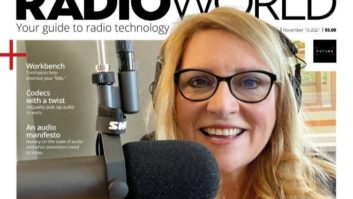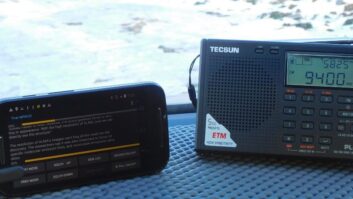In August we told you about the notice of proposed rulemaking submitted by Sennheiser that asked the commission to formally define the Wireless Multi-Channel Audio System as a new class of wireless mics. The company also requested that WMAS be allowed to occupy up to a 6 MHz channel bandwidth.
The advantage, according to Sennheiser, is that by digitally combining signals from multiple devices into a 6 MHz channel, intermodulation issues would be eliminated while permitting denser use of the spectrum and reducing power density across the channel.
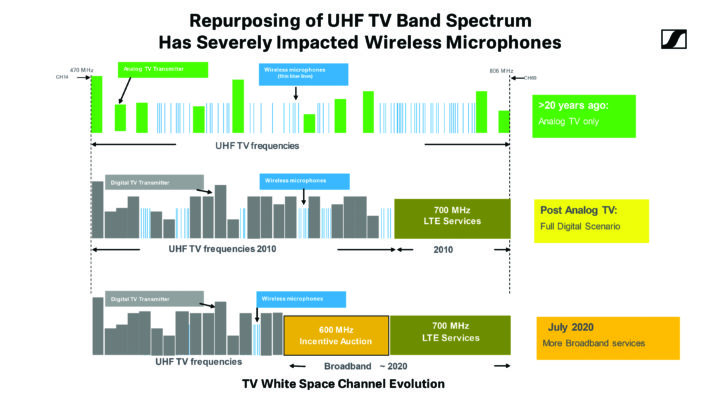
Shure has also been a supporter of the WMAS concept in general.
As we reported, the proposal had generated a flurry of comments from several parties, most generally in agreement with Sennheiser’s concept of WMAS but with varied suggestions on how it could be tweaked and improved.
Late this summer, followup comments were filed, with interested parties reacting to one another’s ideas.
Worried about interference
Lectrosonics expressed concerns that the proposed systems, by virtue of the wide bandwidths they occupy, will harm access to spectrum in situations where multiple operators must share a limited amount of spectrum.
It added its support to a key recommendation from the National Association of Broadcasters. Essentially, the NAB asked the commission to limit the use of WMAS to large events. Lectrosonics agreed with the NAB that the FCC should set a minimum threshold of 10 audio channels used by a single entity, and that the audio channels be under the control of a single entity, so that there would be a single point of contact for other wireless microphone operators.
[More: Wireless Mic Industry Debates WMAS Technology]
Lectrosonics agreed with Shure that the commission should permit Part 74 WMAS operations in the VHF-TV bands (54–72, 76–88 and 174–216 MHz), the UHF-TV band (470–608 MHz), the 653–657 MHz segment of the 600 MHz duplex gap, 941.5–944 MHz, 944–952 MHz, 952.850–956.250 MHz, 956.45–959.85 MHz, 1435–1525 MHz, 6875–6900 MHz and 7100–7125 MHz (“6–7 GHz”) bands as proposed in the NPRM.
However, Lectrosonics disagreed with Shure’s idea that the commission allow unlicensed WMAS operations and adopt technical rules for Part 15 WMAS technologies.
The operation of unlicensed wideband WMAS systems in situations where spectrum availability is limited, said Lectrosonics, incurs the risk of interference to licensed wireless microphone operations. They added that unlicensed users can continue to operate narrowband wireless microphones as in the past.
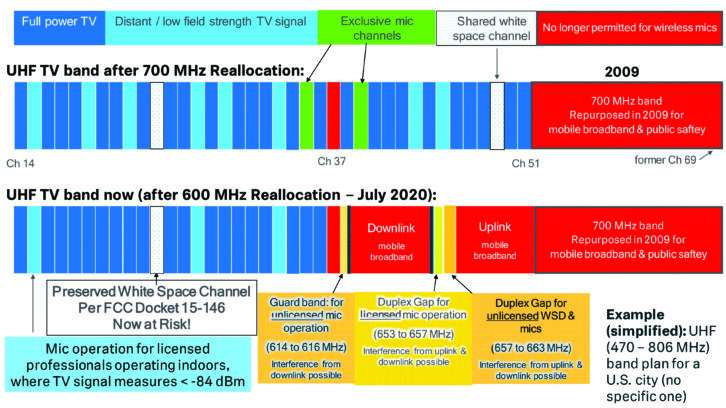
Lectrosonics favors a sliding scale for Part 74 WMAS power levels. While Shure proposed power spectral density (“PSD”) levels up to 750 mW per megahertz for Part 74 users based on the 250 mW limit for LPAS devices and a minimum spectral efficiency of 3 channels per megahertz, Lectrosonics says in its experience, a power level of 50 mW is typical. This, the company says, should be taken as the basis for sliding scale power spectral density limits.
The company also weighed in on whether the commission should reallocate the 6–7 GHz frequencies now designated for wireless microphones. It sided with Shure, saying in part, “this allocation has great promise for wireless microphone usage and that wireless microphone manufacturers, including Lectrosonics, are planning to develop systems that operate there.”
Finally, Lectrosonics added that the commission should require a minimum spectral efficiency of three audio channels per MHz for WMAS technology, and the maximum bandwidth should be limited to six MHz, but no minimum bandwidth requirements should be imposed.
Not just for large events
Waves Audio Ltd. agreed with the value of harmonizing WMAS regulations with European Telecommunications Standards Institute standards, but disagreed with the use of the ETSI emission mask. That, it said, would force manufactures to use cost-prohibitive measures in order to comply. Rather, the company suggested the commission adopt the emissions mask Waves proposed in its own initial comments.
Waves advocates for the commission to adopt a minimum efficiency level of three channels per MHz. It noted that the proposed six channels per MHz advocated by the NAB was not tenable, and agreed with Shure, which said three channels was optimal.
Waves and Shure disagree as to whether the commission should mandate a measurement of audio quality, with Waves arguing against. It said the state of the art in wireless microphones delivers “unheralded fidelity,” that codec audio quality is a major source of innovation and that any attempt to regulate sound quality could stifle this kind of creativity.
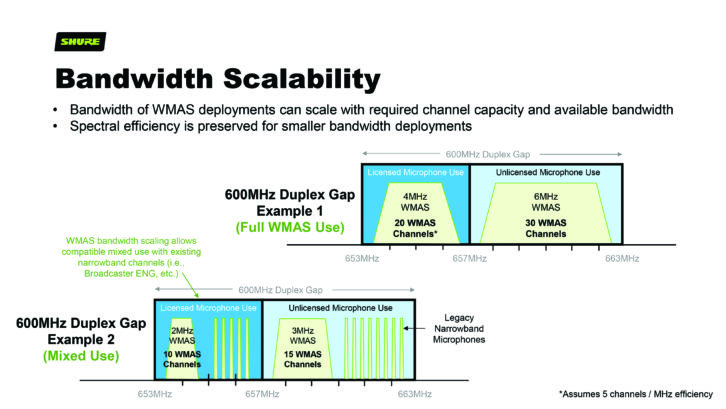
Waves disagreed with the NAB’s recommendation to constrain WMAS usage to large events, citing a number of reasons and calling this an artificial cap. A 10-channel minimum usage requirement would, according to Waves, probably cause users to take up more channels than they need just so they can use WMAS. Alternately, they might purchase both a conventional wireless microphone system along with a WMAS system.
Further, Waves wondered how such a requirement would be enforced. And even if it could be, the company said limiting use to large events would deprive smaller and mid-scale users of the advantages of WMAS; that in turn would slow the adoption curve, which would cause manufactures to reduce their investments in the technology.
Waves said the commission should scale WMAS bandwidth based on the number of carriers transmitted, rather than the number of audio channels used.
In this regard, the company strongly disagrees with the approach recommended by Shure, where the spectral efficiency of WMAS systems would be no less than an average of three channels per MHz across all channels, such that when using less than three audio channels a system must operate under the definition of narrowband.
Waves took issue with the NAB stance opposing WMAS operations under Part 15 at lower power. The company said that permitting Part 15 users will lead to higher and quicker adoption of the emerging standard, resulting in higher efficiency use of spectral resources overall.
Appropriate guardrails
NCTA—The Internet & Television Association focused on the need for coexistence measures for any WMAS operations in the 6 GHz band. It said the FCC thus would acknowledge the needs of wireless microphone users while allowing existing BAS and unlicensed users in the 6 GHz band to thrive.
Specifically, NCTA asked that the commission cap the total power permitted in a single WMAS channel; require that WMAS channelization be harmonized with BAS and 802.11 Wi-Fi channelization to avoid WMAS channels overlapping more than one of the channels of these other services; allow WMAS channels of up to six MHz, but not more; permit only Part 74 licensed WMAS use in 6 GHz; and restrict use to large events that require the use of many audio channels at the same time.
[Subscribe to Radio World Engineering Extra]
ViacomCBS sided with the NAB in asking the commission to place limits on the use of the technology, to ensure that it does not impede broadcasters from engaging in newsgathering and coverage of local events of interest to their communities. The company added, “The spectrum needed for local broadcasters to operate wireless microphones is already scarce, and overbroad authorization of WMAS may exacerbate this problem. Appropriate guardrails on WMAS operations are needed to avoid disruption to local news and event coverage.”
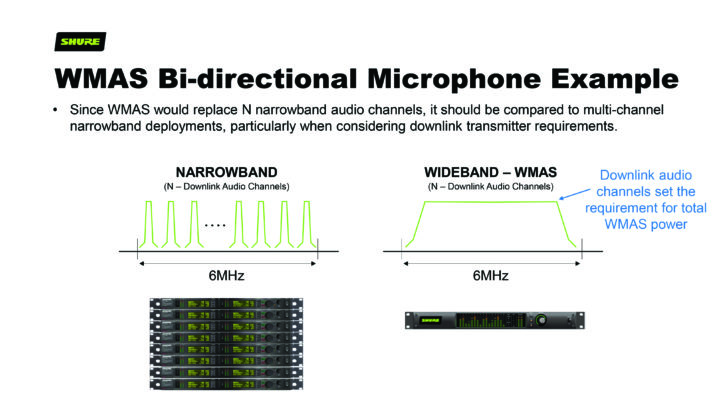
Sennheiser stated its support for preservation of a vacant UHF TV channel for wireless microphone use in all market areas of the United States. It said that petitions for reconsideration filed by both Shure and Sennheiser have broad support, with 183 of the 184 parties submitting comments supporting adoption of a vacant low-band UHF TV channel for wireless mic operations.
Cisco Systems, Facebook, Qualcomm and Intel filed jointly. They focused their reply comments on proposals for the 6 GHz and 7 GHz bands.
They began by noting that they all produce unlicensed technology and thus are now stakeholders in the band. The four companies do not believe that proponents have established a case for WMAS in 6 and 7 GHz. Noting that Sennheiser had not sought rule changes to permit WMAS in these bands, they believe the record casts substantial doubt on the technical wisdom of doing so.
At the same time, they believe the record reveals minimal use of wireless microphones under LPAS rules. The consequence, Cisco and Facebook wrote, is that there is “negligible” harm in directing wireless microphone operations to the other bands that have proven to have strong utility for the wireless microphone user community.
Finally, they said that allowing a WMAS allocation to proceed at 6 and 7 GHz creates uncertainties for unlicensed deployments that could slow the pace of innovation and uptake of new RLAN technology.
Do no harm
Microsoft Corp. stated its opposition to WMAS operations in the 6875–6900 and 7100–7125 MHz bands, asking the FCC to remove “needless regulatory uncertainty” and avoid economic harm.
Microsoft sided with the NAB in opposing unlicensed WMAS operations, which Shure and Sennheiser support. At issue, according to Microsoft, is the use of unlicensed WMAS operations as an opportunity to circumvent the FCC’s current eligibility threshold for unlicensed users to obtain a Part 74 license.
Shure responded to comments about the company’s recommended WMAS power levels of 750 mW per megahertz PSD and unlicensed 150 mW per megahertz PSD.
It noted that these are based on equivalency to power levels permissible under existing narrowband rules, and said they have worked very well for years without raising reported instances of interference to co-channel or adjacent channel operation.
Shure also urged the FCC to align its WMAS regulations with the ETSI harmonized standard with respect to transmit mask requirements and intermodulation distortion limits.
The NAB’s own reply comments expanded on its concerns over spectral efficiency.
“While we continue to support the use of WMAS technology on a secondary basis subject to reasonable restrictions, we urge the commission to authorize WMAS only on terms that will actually help alleviate spectrum congestion rather than risk making it materially worse.”
Radio World invites industry-oriented commentaries and responses. Send to Radio World.





